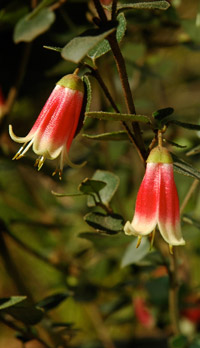Autumn 2014 - Issue 9
Summer 2013/2014 - Issue 8
Spring 2013 - Issue 7
Winter 2013 - Issue 6
Autumn 2013 - Issue 5
Summer 2012/2013 - Issue 4
Spring 2012 - Issue 3
Winter 2012 - Issue 2
Autumn 2012 - Issue 1
A master plan for the Gardens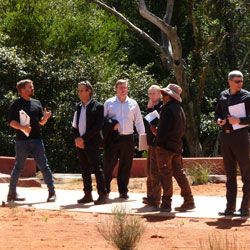
The Gardens is developing a 20-year Master Plan that will provide a blueprint for its future development.
“I’m excited to announce that a consortium of architects and landscape architects, Tonkin Zulaikha Greer and Taylor Cullity Lethlean, have been selected to develop a 20 - year Master Plan for the Australian National Botanic Gardens,” said Senator Simon Birmingham, Parliamentary Secretary for the Environment.
“A key objective is to develop plans for new infrastructure and other attractions to support the growth of the Gardens’ visitor experiences, educational and recreational opportunities without impacting on the precious living plant collection.
“There are lots of ideas on the table, such as a new visitor centre, cafe, pathways and learning experiences for children. The Master Plan will seek to identify the ideal mix of facilities for the future.
“We anticipate phasing in the Master Plan over a 20- year period with funds from a variety of sources including the Parks Australia capital works budget.
“The scope of the Master Plan will also include a new seed bank and horticultural facilities which will increase the horticultural, research and conservation capabilities of this important national institution.
“A public consultation period will be held during December 2014 following the release of the draft concept plan. It is anticipated that the final Master Plan will be developed by June 2015.”
Senator for the ACT, Zed Seselja welcomed the funding, “Canberra has a great reputation as the bush capital and the further enhancement of the Botanic Gardens will attract more tourists to the city.”
The master planning team brings together some of Australia’s leaders in botanic gardens and public park master planning with experience that includes the National Arboretum Master Plan, Australian Garden Cranbourne Botanic Gardens, Adelaide Botanic Gardens Master Plan and the Sanctuary at Tidbinbilla.
Tonkin Zulaikha Greer are architects with a leading reputation for design excellence having won over 100 major design awards at international, national and state levels. Taylor Cullity Lethlean are landscape architects with expertise in open space design and public infrastructure. Taylor Cullity Lethlean is the most awarded landscape architecture practice in Australia.
Art meets science 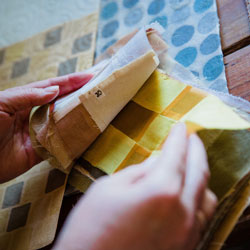
The terms ‘bogs and fens’ may elicit images of swamps or the squelching sounds of gumboots in mud but thanks to Craft ACT’s Artist-in-Residence program bogs and fens have gained a new reputation – an inspiration for art.
The environmental protection of alpine bogs and fens, an endangered ecological community that occurs in small pockets across the Australian Alps - and a breeding habitat for endangered species like the Corroboree Frog - is the theme of the 2014 Craft ACT residency. It is also a theme that is close to the heart of the staff at the National Seed Bank.
Staff at the National Seed Bank are building a unique collection of Australian native seeds for conservation and research, with one particular project focussing on subalpine Sphagnum shrub bogs of the ACT as well as other Sphagnum bogs across the Australian Alps.
“Alpine Sphagnum bogs and associated fens are a nationally listed endangered ecological community,” seed conservation biologist Lydia Guja said.
“As these bogs are exposed to many threats such as fire, weed invasions, grazing and trampling by non-native animals, tourism and increased human infrastructure, here at the National Seed Bank we are contributing to the protection of the Sphagnum bogs with a two – part project.
“We have collected seeds from Sphagnum bogs for research and long term storage at the National Seed Bank. These seeds were collected sustainably and by hand thanks to the collaborative effort of Gardens’ staff and volunteers, ACT Government rangers and ACT conservation and research staff.
“The collection program would not have been this successful without the high quality information - a result of years of research by alpine and peatland experts, that was available to inform our collection program.
“Overall, 232 seed collections and have been made in the ACT, NSW and Tasmania over the past 2 years.
“Now that the seeds have been collected and stored, the next step is to undertake research into the seed ecology/biology of bog and fen plants to better understand seed persistence in the soil and germination and dormancy cycles that seeds undergo in the wild - therefore informing us about conservation management and restoration issues. Experiments are underway and focussing on 13 species which are important components of the plant communities.”
The alpine bogs and fens theme for this year’s Artist-in-Residence program provided artists with the opportunity to link ideas, feelings and motivations from field experience of the bogs and fens, together with originality and vision inspired by texture and structure of plants in the Gardens.
Associating the artists directly with the field environment - in both Namadgi National Park and the Gardens – provided stimulation and prompting of their imagination, resulting in outstanding creativity.
The Artist-in-Residence program has highlighted the different and complementary ways that an artist and an ecologist/botanist might interpret the same features of a bog - bringing together two very different conservation stories.
An exhibition at Craft ACT showcasing the work of the Artists-in-Residence will run from 10 April to 16 May 2015.
A special exhibition highlighting the artists’ research, preparatory and developmental work will be held at the Gardens later in 2015.
Red Centre Garden turns one! 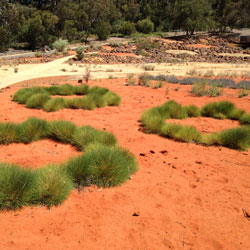
One year on, the Red Centre Garden has been a journey of discovery for Gardens’ staff and visitors alike.
“The Red Centre Garden has now lived through Canberra’s four distinct seasons and plants such as the rare Acacia ammobia (Mt Conner Wattle) have thrived,” curator of Living Collections David Taylor said.
“This is the first time Acacia ammobia has been cultivated in the Gardens and shows signs it may be a species suitable for cultivating in dry home gardens in Canberra.
“Since the opening of the Red Centre Garden, we have added new species including Quandong plants (Santalum acuminatum), a plant widely dispersed throughout the deserts of Central Australia.
“Quandong is hemiparasitic and needs a host plant to attach its roots to, allowing it to acquire water and some of its nutrients from the host plant. We had to use specialist techniques in our Nursery to establish this hemiparasitic relationship.”
The Red Centre has become a major feature for the Gardens. The Gardens’ afterDARK Rainforest to Red Centre tours have been a great success and popular amongst locals and interstate visitors.
Garden Guidance: Hot tip of the season 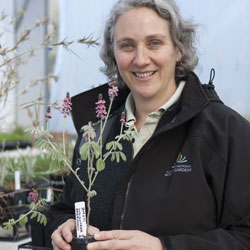
Looking for ways to care for your garden during spring? Gardens' Nursery Horticulturist Heather Sweet has this season's hot tip.
During spring, Heather says to keep a careful eye on your watering. Plants can dry out quickly if there is minimal rain. Heather also says that finicky plants can die if they sit too cold and wet before they are actively growing so you need to keep an eye on that too.
"At the Gardens’ Nursery, we hand-water our plants as their water requirements vary so much this time of the year. We will also be moving the plants currently growing in the protected tunnels into our shadehouse to harden off before spring planting.
"Don’t forget that we can still experience frosty mornings during spring so make sure that your frost sensitive plants are still kept undercover."
Heather has worked at the Gardens for 16 years and her favourite part of the Gardens is the view into the Rainforest Gully canopy - from the road that runs down the southern side of the Gully.
Exploring Townhouse Gardens in the Ancient Roman World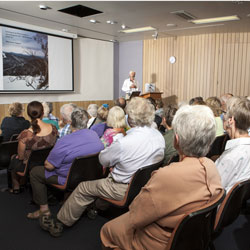
During a recent Friends public talk, Professor Elizabeth Minchin, Professor of Classics in the ANU Centre for Classical Studies, discussed how she looked at the garden areas of the freestanding atrium townhouses of Pompeii to reconstruct the appearance – the layout, the plantings and the ornamentation – to assess the importance which a garden assumed in the Roman world.
One of the most fascinating aspects of this talk was the sources of information on these townhouse gardens. As Professor Minchin noted, until recent times the only sources of information were Pliny's descriptions of his gardens at his villas at Laurentum and Tifernum (Letters 2.17 and 5.6); hundreds of wall paintings preserved at Pompeii after the eruption of Vesuvius; and scattered observations of the 450 or so houses in Pompeii which had gardens.
The range of available sources has been amplified in the last 40 years by the pioneering work of the late Wilhemina Jashemski whose archaeological investigations, focused on the evidence of gardens and horticulture in Pompeii, mostly confirm, and supplement, the conclusions drawn from these other sources.
The Friends of the Gardens conduct a lunchtime talks program (12.30 to 1.30pm) at the Gardens each Thursday from February until the end of November each year. These popular and informative Thursday Talks have a broad subject-matter, starting with botany but ranging across the natural world. Other recent topics have included reflections on the history of the floras of South Africa and Australia, and discussion of the achievements of the late Professor Lindsay Pryor, an internationally-respected forest scientist, botanist and landscape architect.
For further information about the Friends’ Thursday Talks program, visit www.friendsanbg.org.au/
![Director of National Parks [logo]](../../../images/dnp_90px.gif)





